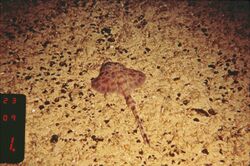Biology:Fenestraja plutonia
| Fenestraja plutonia | |
|---|---|

| |
| Scientific classification | |
| Domain: | Eukaryota |
| Kingdom: | Animalia |
| Phylum: | Chordata |
| Class: | Chondrichthyes |
| Subclass: | Elasmobranchii |
| Superorder: | Batoidea |
| Order: | Rajiformes |
| Family: | Gurgesiellidae |
| Genus: | Fenestraja |
| Species: | F. plutonia
|
| Binomial name | |
| Fenestraja plutonia (Garman, 1881)
| |
| Synonyms | |
| |
Fenestraja plutonia is a species of cartilaginous fish in the family Gurgesiellidae. It is commonly known as the underworld windowskate or Pluto pygmy skate.[2] The underworld windowskate is known from patches of continental slope in the western Atlantic Ocean between the coasts of the southern United States and Suriname.[1]
Etymology
The underworld windowskate's genus name, Fenestraja, comes from a combination of two words. Fenestre is a Latin word meaning window, which in this case refers to a small opening in bone.[3] A second Latin word, Raja simply refers to the genus as a skate/ray of the family Rajidae. Its species name is a reference to Pluto (Ancient Greek:, Script error: The function "transl" does not exist.) the Greek god of the underworld.[4]
Taxonomy

The underworld windowskate was initially described by Samuel Garman in 1881 as Raja plutoni. Garman also considered placing the species in other genera such as Breviraja and Gurgesiella.[5] The first specimens had been caught during dredging of the Atlantic coast during the summer of the previous year.[5] In 1947, another skate from the Gulf Stream was described by Henry Fowler as Raja acanthiderma.[6] However this species designation has been suggested to be a synonym for the underworld windowskate, once the species was officially moved from Raja to Fenestraja.[7]
Description
The underworld windowskate has a heart-shaped disc, with denticles on the blunt snout, around the eyes, on the pectoral fins and down the sides of the long tail.[8] It is generally yellowish, grayish, or purplish brown on top, with dark spots. The ventral surface is yellow-white, and the tail has several dark bands.[8]
Distribution and habitat
According to the IUCN, five populations of the underworld windowskate are known, all from the western Atlantic Ocean.[1] The northernmost ranges on the North American continental shelf from North Carolina to Key West, including the Straights of Florida.[1] Another population is known from the waters around Andros Island in the Bahamas and in the Tongue of the Ocean.[1] A third area of continental shelf, this time in the Gulf of Mexico from the Chattahoochee River delta to the Mississippi River Delta is also known to contain the species.[1] Finally, two widely separated groups occupy the southern Caribbean Sea, the first off Costa Rica, near Puerto Limon, and the second from the South American continental shelf near Caracas, Venezuela, to Paramaribo, Suriname.[1]
Outside of these general ranges, specimens have been collected from the waters off Colombia, Ellesmere Island, in the eastern Gulf of Mexico, and James Bay, Canada .[9] Individuals have also been spotted by divers in southern Mexico, and in 1891 a specimen supposedly belonging to F. plutonia was collected from the California coast, even though the underworld windowskate is overwhelmingly an Atlantic species.[9][10]
See also
References
- ↑ 1.0 1.1 1.2 1.3 1.4 1.5 1.6 Crysler, Z., Kyne, P.M., Lasso-Alcalá, O., Mejía-Falla, P.A., Navia, A.F. & Herman, K. (2020). "Fenestraja plutonia". The IUCN Red List of Threatened Species (IUCN) 2020: e.T161642A124520072. https://www.iucnredlist.org/species/161642/124520072. Retrieved 18 January 2021.
- ↑ Froese, Rainer and Pauly, Daniel, eds. (2011). Species of Fenestraja in FishBase. February 2011 version.
- ↑ Romero, P., 2002. An etymological dictionary of taxonomy. Madrid, unpublished.
- ↑ William Hansen, Classical Mythology: A Guide to the Mythical World of the Greeks and Romans. Oxford University Press, 2005
- ↑ 5.0 5.1 Garman, S. 1881 (Apr.) Report on the selachians. Reports on the results of dredging, ... along the Atlantic coast of the United States during the summer of 1880, by the U. S. Coast Survey Steamer "Blake," Commander J. R. Bartlett, U. S. N., commanding. XII. Bulletin of the Museum of Comparative Zoology v. 8 (no. 11): 231–237.
- ↑ Fowler, H. W. 1947 (June) A new skate from the Gulf Stream off east Florida. The Fish Culturist v. 26 (no. 10): 73–75.
- ↑ McEachran, J.D. and K.A. Dunn, 1998. Phylogenetic analysis of skates, a morphologically conservative clade of elasmobranchs (Chondrichthyes: Rajidae). Copeia 1998(2):271–290.
- ↑ 8.0 8.1 Kells, Val., Carpenter, Kent. A Field Guide to Coastal Fishes From Maine to Texas. 2011. Johns Hopkins University Press. pg 86.
- ↑ 9.0 9.1 Global Biodiversity Information Facility Records. 6 June, 2014
- ↑ Global Biodiversity Information Facility, Occurrence Records. 2 May 2015
External links
Wikidata ☰ Q5033252 entry
 |


